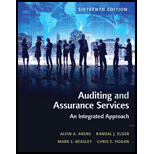
Auditing and Assurance Services, Student Value Edition (16th Edition)
16th Edition
ISBN: 9780134075754
Author: Alvin A. Arens, Randal J. Elder, Mark S. Beasley, Chris E. Hogan
Publisher: PEARSON
expand_more
expand_more
format_list_bulleted
Question
Chapter 15, Problem 24.1MCQ
To determine
Explain advantage of statistical sampling over non-statistical sampling is that statistical sampling helps an auditor:
Expert Solution & Answer
Want to see the full answer?
Check out a sample textbook solution
Students have asked these similar questions
None
What is the amount of unpaid interest
Please help me
Chapter 15 Solutions
Auditing and Assurance Services, Student Value Edition (16th Edition)
Ch. 15 - Prob. 1RQCh. 15 - Prob. 2RQCh. 15 - Prob. 3RQCh. 15 - Prob. 4RQCh. 15 - Prob. 5RQCh. 15 - Prob. 6RQCh. 15 - Prob. 7RQCh. 15 - Prob. 8RQCh. 15 - Prob. 9RQCh. 15 - Prob. 10RQ
Ch. 15 - Prob. 11RQCh. 15 - Prob. 12RQCh. 15 - Prob. 13RQCh. 15 - Distinguish between the TER and the CUER. How is...Ch. 15 - Prob. 15RQCh. 15 - Prob. 16RQCh. 15 - Prob. 17RQCh. 15 - Prob. 18RQCh. 15 - Prob. 19RQCh. 15 - Prob. 20RQCh. 15 - Prob. 21RQCh. 15 - Prob. 22.1MCQCh. 15 - Prob. 22.2MCQCh. 15 - Prob. 22.3MCQCh. 15 - Prob. 23.1MCQCh. 15 - Prob. 23.2MCQCh. 15 - Prob. 23.3MCQCh. 15 - Prob. 24.1MCQCh. 15 - Prob. 24.2MCQCh. 15 - Prob. 24.3MCQCh. 15 - Prob. 25.1MCQCh. 15 - Prob. 25.2MCQCh. 15 - Prob. 25.3MCQCh. 15 - Prob. 27DQPCh. 15 - Lenter Supply Company is a medium-sized...Ch. 15 - Prob. 29DQPCh. 15 - Prob. 30DQPCh. 15 - Prob. 31DQPCh. 15 - Prob. 32DQPCh. 15 - Prob. 33DQPCh. 15 - Prob. 34DQPCh. 15 - Prob. 35DQPCh. 15 - Prob. 36CCh. 15 - Prob. 37ICA
Knowledge Booster
Similar questions
- A traveling production of Fame Broadway performs each year. The average show sells 1,500 tickets at $60 per ticket. There are 120 shows each year. The show has a cast of 70, each earning an average of $350 per show. The cast is paid only after each show. The other variable expense is program printing costs of $7 per guest. Annual fixed expenses total $1,500,000. Requirements: Compute revenue and variable expenses for each show.arrow_forwardhello tutor provide answer of this General accounting questionarrow_forwardMCQarrow_forward
- What are the revenues for divisions M?arrow_forwardHarper Manufacturing produces a special type of polymer used in medical devices. In 2022, the first year of operations, Harper produced 5,500 tons of polymer and sold 3,200 tons. In 2023, the company produced the same amount but sold 6,500 tons (i.e., selling all of its inventory). The selling price per ton was $1,800, variable manufacturing costs per ton were $350, and variable selling expenses were $500 per ton. Fixed manufacturing costs were $3,500,000, and fixed administrative expenses were $600,000. Compute net income under variable costing for 2022.arrow_forwardBurson Enterprises' May 31 bank reconciliation shows deposits in transit of $850. The general ledger Cash in Bank account shows total cash receipts during June of $48,500. The June bank statement shows total cash deposits of $44,300 (including $1,500 from the collection of a note; the note collection has not yet been recorded by Burson). What amount of deposits in transit should appear in the June 30 bank reconciliation? Helparrow_forward
arrow_back_ios
SEE MORE QUESTIONS
arrow_forward_ios
Recommended textbooks for you
 Auditing: A Risk Based-Approach (MindTap Course L...AccountingISBN:9781337619455Author:Karla M Johnstone, Audrey A. Gramling, Larry E. RittenbergPublisher:Cengage Learning
Auditing: A Risk Based-Approach (MindTap Course L...AccountingISBN:9781337619455Author:Karla M Johnstone, Audrey A. Gramling, Larry E. RittenbergPublisher:Cengage Learning Auditing: A Risk Based-Approach to Conducting a Q...AccountingISBN:9781305080577Author:Karla M Johnstone, Audrey A. Gramling, Larry E. RittenbergPublisher:South-Western College Pub
Auditing: A Risk Based-Approach to Conducting a Q...AccountingISBN:9781305080577Author:Karla M Johnstone, Audrey A. Gramling, Larry E. RittenbergPublisher:South-Western College Pub

Auditing: A Risk Based-Approach (MindTap Course L...
Accounting
ISBN:9781337619455
Author:Karla M Johnstone, Audrey A. Gramling, Larry E. Rittenberg
Publisher:Cengage Learning

Auditing: A Risk Based-Approach to Conducting a Q...
Accounting
ISBN:9781305080577
Author:Karla M Johnstone, Audrey A. Gramling, Larry E. Rittenberg
Publisher:South-Western College Pub